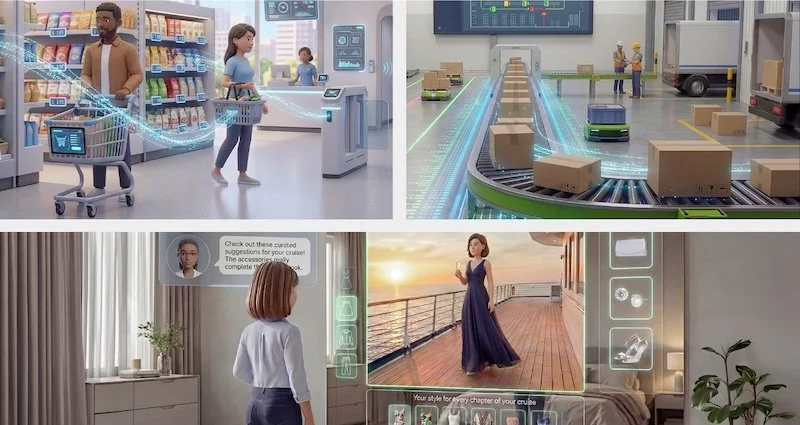Retail Technology Startup Stories Interview: Serge Milbank, Chief Executive Officer at Confer With
RTIH gets the lowdown on live video shopping specialist and 2023 RTIH Innovation Awards nominee, Confer With, from CEO Serge Milbank.
RTIH: Tell us about yourself and Confer With.
SM: Confer With is like a shoppable face time call, triggered from retail and direct to consumer websites and we help scale personal shopping.
We replicate the experience someone might have in a retail store, so you can connect directly with a store associate, but it’s all connected to e-commerce so the store associated can help customers through choosing the right product to buy.
The super power is that we surface the entire e-commerce catalogue – images, videos, pricing, inventory levels, so store associates can share choices across the whole product range, and do things like share images of the product, videos, product descriptions and more.
This allows an e-commerce website to provide personal shopping services at scale, because the traffic on websites is generally much higher than footfall, there are a lot of potential customers on websites that are not getting the quality of experience you can get inside a store.
Myself, I’m the CEO of Confer With as well as one of the founders. I’ve had a long history in digital, my last business was a digital consulting firm Stream:20 that advised businesses like Amazon, Sky, Vodafone, Experian and others on how to scale digital. We sold that business to the data firm CACI and that helped fund the early stages of Confer With.
RTIH: What was the inspiration behind setting the company up?
SM: We started in the Covid lockdowns – I think the company was established in June 2020. What we were witnessing was retail pretty much shut down in that period.
The ratio of e-commerce to retail (in terms of revenue) changed significantly in the favour of e-commerce. Statistically speaking though, we were looking at what things would look like in ten years’ time.
The need for direct interaction was very much still there – the store has a role in the decision-making process. It manifested in increased use of social commerce, increased use of video (on things like zoom calls in retail). So there was clearly a need there.
We studied what actually happens inside a retail store. The first thing we learned was that a store converts at a much higher rate than websites – like a factor of 10 to 20. Often higher for high value goods.
We mapped the customer journey in a store as it relates to human interaction. Retail has a process – and its been honed over decades, probably centuries, and it works.
The combination of human interaction with guided choice and immersion in product, use of the till to close a sale. All of this improves conversion and its fundamentally different to the way it’s done online.
We set about building a video interaction that leveraged website traffic, and the scalability of e-commerce, but with the personal nature of shopping in a retail store. The result is Confer With.
We knew we had sight of what retail interaction could be in the future – so the goal of the business is to give an entirely new shopping experience, knowing full well which direction customer behaviour is going.
RTIH: What has been the industry reaction thus far?
SM: We started taking video calls in early 2021 – so getting toward the end of lockdowns.
We bypassed a lot of the craziness and intensity of the first wave of live video shopping, which was a good thing. We were looking for clients who were interested in building live video as a channel.
Customers love it. We have an average Net Promoter Score of anywhere between 70 and 80 depending on the month. Customers who can’t get to a store due to things like distance, accessibility or people not ready to commit to a store visit, are getting access to a personal shopping experience.
That naturally suits the big omnichannel players out there, or retailers/brands with a limited store network. Interestingly, pureplay e-commerce also performs well.
You don’t need a physical store. You could be taking calls from home, or from what we call visual studios, which are purpose built rooms, that might have some stock there, but without the noise and distractions of the shopfloor.
A physical space helps because of the video, but the e-commerce capabilities of Confer With reduce the need for a full physical space.
From a sector perspective – in retail, we are seeing take-up with furniture and homewares, fashion, consumer electronics, sporting goods, beauty, luxury goods like jewellery and watches.
Anything that a customer is likely to have a question about, Confer With can save a sale before they abandon to a competitor (or not buying at all).
RTIH: What has been your biggest challenge/setback?
SM: I think our biggest challenge has been having to follow technology that has a specific use case of store associates flipping their camera inside a store and showing product to customers.
During lockdown – the prevailing technology was just that – and I think the whole of the retail market understands that to be the way that it should be done.
Unfortunately, retailers that understand that as “the” use case probably did okay with it in a lock down – but it didn’t work when stores reopened. We knew that would happen – and that is why we built a whole e-commerce framework around Confer With – a video commerce framework.
As a result, we have a lot of retailers who have tried the video only use case and failed with it. So there is a bit of work needed on our side to show what can be done, and what can be done is pretty cool now.
Video commerce can be executed from studios in contact centres, with specialist virtual consultants, or personal shoppers working from home.
RTIH: What are the biggest challenges facing retailers right now?
SM: I think when you speak to retailers, probably their biggest challenge is hiring staff to work in the stores. The world has changed - people are working hybrid.
There are so many benefits for the worker to be working hybrid. That is of course true in the corporate sector, but we forget that people in retail want to have the same benefit – they want to be working from home too.
Retail is seen as a transitory job for many, with limited possibilities for growth. There is a big change afoot in the way people will be approaching work in retail.
We set out to build a career path for people working in retail and that pathway is over video. Retail workers can now work hybrid, there are flexible work options available to the retail worker that might otherwise have dropped out of retail.
I know that the people taking video calls on Confer With – love operating over video. It’s a thing they enjoy Importantly, when you have an opportunity to operate over video – this creates a career path into the one to many space – in live shopping, which I think suits a lot of the Gen Z workers entering the market.
RTIH: What's the best question about your company or the market asked of you recently by a.) an investor and b.) a customer?
SM: I think investors are always asking questions about “how do you scale it” and it’s a good question. Intuitively they think because it’s got people involved – it’s not as scalable or there’s a hidden cost there.
We have a metric that we calculate that is revenue generated per minute – and it’s a great metric because it demonstrates how the unit economics play out. It is hugely profitable. More profitable than the most profitable channel – the store.
You have the selling ability of people, which pushes up the e-commerce metrics (conversion rate and average order value) to a point that it makes absolute sense. Importantly, the overhead of store costs are not there. It’s a counterintuitive win-win.
If you’re talking about an end customer – the question I love is “why can’t I shop like this all the time?” I think people love the way they can shop like retail, but from the convenience of their own home.…but I think you are talking about the client/customer – the most interesting one I have had from a customer was really early on – quite a senior operator.
They asked me what I thought this would mean for someone in property when leases are being renegotiated. I asked them what they meant and they said to me – that the value of a retail lease is naturally dependent on footfall.
If we are pulling traffic from a website, then those metrics go out the window. All of a sudden lower footfall properties become far more valuable to the retailer. That ended up being a long dinner.
RTIH: What can we expect to see from Confer With during 2023 and beyond?
SM: We are expecting a decent amount of growth in the next few years.
We are taking on new retailers, brands and e-tailers every month. As the great change in retail is playing out, Confer With provides, what I think to be a very good solution for some of the problems that are here and we know are coming.
We will be spending a lot of time in the coming year or two building out the toolsets for store associates who are operating on video calls. I think its fair to say we have a very strong toolset that surprises and delights customers. But our dataset on what we know works in personal shopping is vast.
We have a good, strong basis for what to build to enhance the experience for customers and store associates – and importantly what is going to grow the sector that is video commerce and live commerce.
I haven’t talked much about one-to-many live shopping in this interview, which feels strange – but one to many live shopping is like a slightly older cousin we are growing up with. One-to-many live shopping is massive in China, and slightly different versions of it are emerging in Europe and the US.
Because it’s family, we are often categorised as the same thing, but we are different – we serve different stages in the buying journey – but we are super complimentary. The same can be said for chat.
We won’t be developing in that space, but we will be working with our cousins to build this sector out – because it’s a growing concern for anyone in consumer products.















Continue reading…